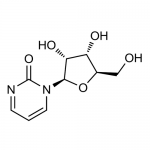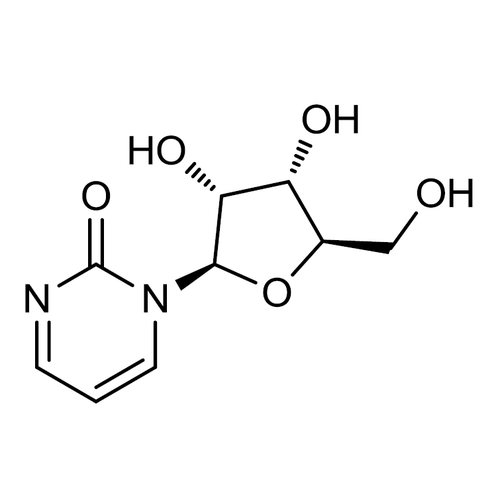| Product Name | Zebularine |
| Description |
DNA methylation inhibitor |
| Purity | >98% (HPLC); NMR (conforms) |
| CAS No. | 3690-10-6 |
| Molecular Formula | C9H12N2O5 |
| Molecular Weight | 228.2 |
| Field of Use | Not for use in humans. Not for use in diagnostics or therapeutics. For in vitro research use only. |
Properties
| Storage Temperature | -20ºC |
| Shipping Temperature | Shipped Ambient |
| Product Type | Inhibitor |
| Solubility | May be dissolved in DMSO (20 mg/ml); or water (20 mg/ml) |
| Source | Synthetic |
| Appearance | White powder |
| SMILES | C1=CN(C(=O)N=C1)C2C(C(C(O2)CO)O)O |
| InChI | InChI=1S/C9H12N2O5/c12-4-5-6(13)7(14)8(16-5)11-3-1-2-10-9(11)15/h1-3,5-8,12-14H,4H2 |
| InChIKey | RPQZTTQVRYEKCR-WCTZXXKLSA-N |
| Safety Phrases |
WHMIS Classification: Not a hazardous substance or mixture. GHS Classification: Not a hazardous substance or mixture. |
| Cite This Product | Zebularine (StressMarq Biosciences Inc., Victoria BC CANADA, Catalog # SIH-560) |
Biological Description
| Alternative Names | 1H-β-D-ribofuranosyl-2-pyrimidinone, NSC 309132, 1-(β-D-Ribofuranosyl)-1,2-dihydropyrimidin-2-one, 2-Pyrimidone-1-β-D-riboside, 1-[3,4-dihydroxy-5-(hydroxymethyl)oxolan-2-yl]pyrimidin-2-one, 4-deoxyuridine, NSC 309132, pyrimidin-2-one beta-D-ribofuranoside, pyrimidin-2-one beta-ribofuranoside, pyrimidin-2-one beta-ribofuranoside, (L)-isomer, pyrimidin-2-one ribonucleoside, zebularine, Pyrimidin-2-one ribonucleoside, Pyrimidin-2-one beta-ribofuranoside, Pyrimidin-2-one beta-D-ribofuranoside |
| Research Areas | Cancer, Cell Signaling, DNA/RNA, Epigenetics and Nuclear Signaling, Mesenchymal Stem Cells, Stem Cells, Tumor suppressors |
| PubChem ID | 100016 |
| Scientific Background | Zebularine is a DNA methyltransferase (DNMT) inhibitor that induces DNA hypomethylation and reactivates silenced genes. In neurodegenerative disease research, Zebularine is used to explore the role of epigenetic modifications in neuronal plasticity, memory, and neuroinflammation. It is particularly relevant in studies of Alzheimer’s disease, where aberrant DNA methylation contributes to gene silencing and synaptic dysfunction. Zebularine’s stability and low toxicity make it a useful tool for investigating epigenetic therapies in the central nervous system. |



Reviews
There are no reviews yet.